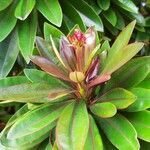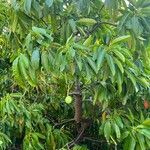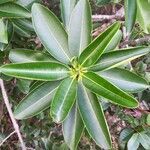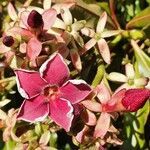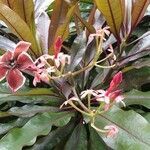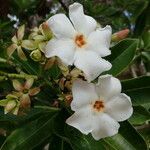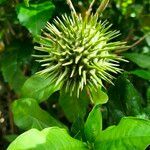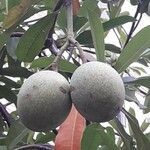Shrub or tree 1.5–25 m high; trunk to 70 cm in diameter; bark grey to dark brown, rough, peeling off in clumps, with large lenticels; wood soft, white; glabrous in all parts except for corolla.. Leaves petiolate; blade coriaceous, narrowly obovate (elliptic), 5–31 cm long, 1–7(–8) cm wide, apiculate to acuminate (rounded or retuse); 15–40 pairs of secondary veins; petiole 1–4.5 cm long.. Inflorescence many-flowered, to 23 cm long, lax near its base but otherwise congested; peduncle 1.5–12 cm long; pedicels 3–28 mm long; bracts sepal-like.. Flowers fragrant, usually only one open per inflorescence; sepals pale green, spreading and often recurved, (4–)8–37 mm long, 2–8 mm wide; corolla tube greenish, 17–55 mm long; lobes white, often pinkish outside, obliquely elliptic to obovate, (9–)14–30(–35) mm long, (5–)9–18(–35) mm wide with 5 white or yellow lanate scales 1.5–3 mm long in the centre, pubescent at the mouth and inside the tube; stamens included, anthers subglobose, 1.5–3 mm.. Fruit of 2 separate (rarely half-connate) mericarps, purplish red or pale green and suffused with red, mericarps ellipsoid, 5–12 cm long, 3–7 cm in diameter.. Fig. 22 (p. 66).
An evergreen tree up to 8 m tall. It can reach 20 m high. It spreads to 2-5 m across. The stem is erect and branching. It has milky sap. The bark is grey brown. The branches come out in whorls, and they are marked with leaf scars. The leaves are bright green. The leaf stalk is 3-6 cm long. The leaf blade is oblong, and narrowing towards the tip. It is 6-37 cm long by 3-8 cm wide. Leaves are deeply veined and arranged in spirals around the stem. The flowers are white with a yellow throat. They are like tubes and 7.5 cm long by 2.5-5 cm across. They occur in dense clusters at the ends of branches. The flowers have a strong scent. The fruit are round and fleshy berries, which are 7.5 cm across. They are pink, tinged with purple. Often the fruit occur in pairs. They hang down.
Tree to 12 m high. Leaves with petiole 15–62 mm long; lamina elliptic-obovate, 15–25 cm long, 4–7 cm wide, cuneate, entire, not sinuate, acute, short-or long-acuminate, discolorous; secondary veins 25–32 each side of midrib; tertiary venation reticulate, prominent. Inflorescence usually with less than 30 flowers. Flowers 30–40 mm long, 20–35 mm diam.; pedicels 10–20 mm long. Sepals lanceolate to lanceolate-ovate, 12–25 mm long. Corolla white with red centre at top of tube; tube 22–35 mm long; lobes ovate to obovate, 18–26 mm long. Fruit ovoid-globose, 6–7 cm long, 3.5–4 cm wide, 3.5–4 cm thick, red when ripe.
Trees to 8 m tall. Bark gray-brown; branches whorled, marked with leaf scars. Petiole 2.5-6 cm; leaf blade narrowly ovate, 6-37 X 2.3-7.8 cm, base cuneate, apex acuminate. Peduncle stout, 5-21 cm. Pedicel terete, 1-2 cm. Flowers 4-7 cm wide. Corolla white, pinkish in center; tube 2.5-4 cm, villous inside ; lobes ovate, falcate, 1.5-2.5 cm. Drupes 5-8 X 4-6 cm, smooth. Seeds usually single. Fl. Mar-Oct, fr. Jul-Dec. 2n = 40.
